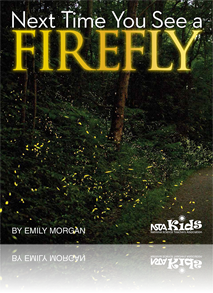Science of Golf: meteorology
By Judy Elgin Jensen
Posted on 2014-07-09
 Living near Tampa—the so-called “lightning capital”—and having a college-golfer (and budding engineer) daughter who plays daily, I’m always a bit jittery about localized storms that pop up regularly here during the summer. With a 60% chance of t-storms this afternoon, she says she’ll keep tabs with a couple of weather apps, and as long as it’s just rain, she’ll pull on her gear and play through it (because that’s what she would have to do in a tournament).
Living near Tampa—the so-called “lightning capital”—and having a college-golfer (and budding engineer) daughter who plays daily, I’m always a bit jittery about localized storms that pop up regularly here during the summer. With a 60% chance of t-storms this afternoon, she says she’ll keep tabs with a couple of weather apps, and as long as it’s just rain, she’ll pull on her gear and play through it (because that’s what she would have to do in a tournament).
But it’s not just lightning that golfers think about during play. Watch Science of Golf: Meteorology and Weather, which explores the development of weather conditions and events and their impact on the game. Although players can use smartphones to access weather data during a round, they aren’t allowed to actually measure conditions on the course. The United States Golf Association (USGA) recently amended the Rules of Golf to clarify how players use these devices. In fact, they included a flowchart that reflects the same kinds of flowcharts engineers use as they develop systems.
NBC Learn’s partnership with the USGA and Chevron brings you yet another application of science concepts in the world of sports. While golf may not be your or your students’ favorite, it rates highly as a lifetime sport, or one that people participate in whether they are 8 or 80. So take a look at the NSTA-developed companion lesson plans and consider taking your science to the course!
Video
SOG: Meteorology and Weather discusses how wind, humidity, and temperature can all impact the next golf shot and examines how weather prediction is crucial for planning and safety at every golf tournament.
STEM Lesson Plan—Adaptable for Grades 7–12
SOG: Meteorology and Weather describes how students might design a golf glove for rainy play or a weather monitoring system, or explore how best to hit a golf ball in strong wind. It also provides ideas for STEM exploration plus strategies to support students in their own quest for answers.
Image of hail on a course, courtesy of Alan English CPA.
You can use the following form to e-mail us edited versions of the lesson plans: [contact-form 2 “ChemNow]
 Living near Tampa—the so-called “lightning capital”—and having a college-golfer (and budding engineer) daughter who plays daily, I’m always a bit jittery about localized storms that pop up regularly here during the summer.
Living near Tampa—the so-called “lightning capital”—and having a college-golfer (and budding engineer) daughter who plays daily, I’m always a bit jittery about localized storms that pop up regularly here during the summer.
Lemonade Stands and Summer Activity Resources
By Peggy Ashbrook
Posted on 2014-07-09
Thanks to a teacher who was moving and in a new job, I received boxes of resources from Zoobooks to CESI publications to posters that will interest children and convey concepts today as well as they did 30 years ago—sorting by an attribute and measuring will always be important in science education. Many of the posters showed families doing things together, emphasizing the role that parents and other adult family members play in children’s education.
 Now that the weather is hot, I see evidence of family support for science and math learning, and review, on neighborhood street corners in the form of lemonade stands. “Made from scratch” lemonade requires cutting open fruit, squeezing the juice out of all the little vesicles in the lemons, measuring water and sugar, and stirring to mix it all together. With a magnifier, children can make close observations of the structure of a lemon, looking closely at the seeds and juice-holding vesicles, and at grains of sugar. Even very young children can learn vocabulary words, “wet” and “dry,” “liquid” and “solid,” and “dissolve.” By making careful observations, children can notice that the sugar
Now that the weather is hot, I see evidence of family support for science and math learning, and review, on neighborhood street corners in the form of lemonade stands. “Made from scratch” lemonade requires cutting open fruit, squeezing the juice out of all the little vesicles in the lemons, measuring water and sugar, and stirring to mix it all together. With a magnifier, children can make close observations of the structure of a lemon, looking closely at the seeds and juice-holding vesicles, and at grains of sugar. Even very young children can learn vocabulary words, “wet” and “dry,” “liquid” and “solid,” and “dissolve.” By making careful observations, children can notice that the sugar  “disappears” as they stir, and by tasting, they can find out if the sugar is “still in the pitcher.” A mini lecture on the dissolution of a solid into a liquid might not be memorable but children will remember if they can continue the exploration into which common and safe solids will dissolve into which common and safe liquids. Salt, sand, baking soda, cornstarch and flour are possibilities to pair with water, vegetable oil and apple juice (it is easier to see any undissolved solids in clear liquids). Provide measuring tools such as teaspoons, measuring cups, and timers (how long did it take the sugar to dissolve?), and a way to document the results, by drawing, dictation or photography. Adult support is also valuable to help children think about what they did. Asking open-ended questions will encourage children to wonder and say what they think is happening. “What do you see?” “Tell me about any changes you see happening.” “How much of the solid do you see in the container?” “How many minutes did it take for the sugar to dissolve?” and “Do you think the sand will dissolve by tomorrow?”
“disappears” as they stir, and by tasting, they can find out if the sugar is “still in the pitcher.” A mini lecture on the dissolution of a solid into a liquid might not be memorable but children will remember if they can continue the exploration into which common and safe solids will dissolve into which common and safe liquids. Salt, sand, baking soda, cornstarch and flour are possibilities to pair with water, vegetable oil and apple juice (it is easier to see any undissolved solids in clear liquids). Provide measuring tools such as teaspoons, measuring cups, and timers (how long did it take the sugar to dissolve?), and a way to document the results, by drawing, dictation or photography. Adult support is also valuable to help children think about what they did. Asking open-ended questions will encourage children to wonder and say what they think is happening. “What do you see?” “Tell me about any changes you see happening.” “How much of the solid do you see in the container?” “How many minutes did it take for the sugar to dissolve?” and “Do you think the sand will dissolve by tomorrow?”
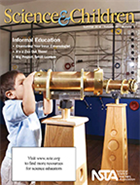 The July 2014 issue of Science and Children has a collection of articles on informal science experiences, including the free article, Channeling Your Inner Entomologist by Tara C. Bell and Tara A.W. McGill, and my Early Years column about inviting parents to school and making lemonade from scratch. Kids Gardening has an article about beneficial insects, those “that behave in ways that are helpful to the crops we grow.”
The July 2014 issue of Science and Children has a collection of articles on informal science experiences, including the free article, Channeling Your Inner Entomologist by Tara C. Bell and Tara A.W. McGill, and my Early Years column about inviting parents to school and making lemonade from scratch. Kids Gardening has an article about beneficial insects, those “that behave in ways that are helpful to the crops we grow.”
Children who get to explore through programs at museums, nature centers, aquariums and parks or on family trips to the backyard or across country are exposed to science concepts in ways that go beyond what is possible in the classroom.
Where or how do you suggest children and their families extend their science learning?
Thanks to a teacher who was moving and in a new job, I received boxes of resources from Zoobooks to CESI publications to posters that will interest children and convey concepts today as well as they did 30 years ago—sorting by an attribute and measuring will always be important in science education. Many of the posters showed families doing things together, emphasizing the role that parents and other adult family members play in children’s education.
How Can I Integrate Science and Technology?
By Carole Hayward
Posted on 2014-07-08

Successfully teaching technology in the classroom involves more than just having students use the tools. It involves engaging students and seamlessly incorporating technology into lesson plans. As a former technology coordinator, NSTA member Rena Roybal was tasked with integrating science into K–5 technology classes. She used NSTA resources for content support and help with developing lesson plans.
Roybal: I relied heavily on SciPacks and SciGuides, which both gave me the background I needed to develop lessons that integrated technology and the science that the different grade levels were covering. (Note from NSTA: NSTA members receive a discount on SciPacks and SciGuides.)
I studied the SciPacks so that I would have enough background to teach my students the science lessons. I could have taught purely technology classes, but I find that it’s better if I can work with the grade levels and incorporate my lessons to support what they’re covering at the time. So, I used the Coral Reef Ecosystems SciPack for my fourth-grade lesson. Once I got the science background I needed from the SciPack, I had students conduct online research and also create food webs using Microsoft PowerPoint. Students created the food webs in PowerPoint because it was easy for them to add pictures to the program.
I found the Nutrition SciPack really helpful, too, when we covered the digestive system. I also needed help with classifications, so I spent time studying the Rocks SciPack. I was developing a lesson plan for the third graders who were covering rock classifications. Because I had never taught the upper grades (previously I had taught kindergarten and second grade), the SciPack helped me because I wasn’t familiar with the curriculum and the standards for the third, fourth, and fifth graders I was teaching. For the lesson on rocks, we reviewed classification and then students created thinking maps in Microsoft Word that illustrated the types of classification.
I also used the SciPaks for professional development classes. That helped me grow as a professional and the quizzes allowed me to truly assess myself. I used the SciGuides for assistance on thematic lesson plans and web-based resources.
How else has your NSTA membership helped you in your career?
Roybal: The Community Forums in the Learning Center are very helpful. Sometimes, I just log on and browse the forums. Even if the topic is not something I’m currently working on, I find it helpful to see what other teachers are doing. Getting feedback from other teachers helps you generate classroom ideas. I also like that you can search for resources on the Learning Center based on state standards. For me, NSTA is such a wealth of resources.
Not a member of NSTA? Learn more about how to join.
Jennifer Henderson is our guest blogger for this series. Before launching her freelance career as a writer/editor, Jennifer was Managing Editor of The Science Teacher, NSTA’s peer-reviewed journal for high school science teachers.
Science of Golf: Newton 1 & 2
By Judy Elgin Jensen
Posted on 2014-07-07
 From 0 to 175 mph in a fraction of a second, today’s top golfers can turn a golf ball into one of the fastest projectiles in sports. Science of Golf: Newton’s First and Second Laws of Motion showcases the insights of Suzann Pettersen, a professional golfer on the LPGA Tour who turns force and motion into dollars.
From 0 to 175 mph in a fraction of a second, today’s top golfers can turn a golf ball into one of the fastest projectiles in sports. Science of Golf: Newton’s First and Second Laws of Motion showcases the insights of Suzann Pettersen, a professional golfer on the LPGA Tour who turns force and motion into dollars.
Pettersen may not be thinking about Newton’s Laws of Motion while stalking her competitors on the golf course but she obviously knows that “there’s nothing that beats hitting a pure golf shot.” I dare to say that most athletes think little about the science behind the critical actions of their sport. But it can be just the thing to help your students connect what they read and experience in the classroom to real life. NBC Learn and its partners think so. The Science of Golf is the latest installment of NBC Learn’s Emmy Award-winning “Science of Sports” series. Developed in partnership with the United States Golf Association (USGA) and Chevron, the Science of Golf is available cost-free on www.NBCLearn.com.
The companion NSTA-developed lesson plans give you a lot of ideas for how to use the videos as a centerpiece, or simply incorporate them into what you already do. Look through the lesson plans and adapt any part that is most useful to you. We all know that everyone’s situation is just a bit different, so download the Word doc and modify at will to make it your own. After you give them a try with your students, let us know what you think! Suggestions for improvements are always welcome. Just leave a comment and we’ll get in touch with you.
Video
SOG: Newton’s First & Second Laws of Motion is about how the First and Second Laws of Motion influence what happens to the golf ball.
STEM Lesson Plan—Adaptable for Grades 7–12
SOG: Newton’s First & Second Laws of Motion guides students in exploring the interaction between mass and force or the efficiency of a more massive golf club. It also provides ideas for STEM exploration plus strategies to support students in their own quest for answers.
Image of Suzann Pettersen courtesy of Keith Allison.
You can use the following form to e-mail us edited versions of the lesson plans: [contact-form 2 “ChemNow]
 From 0 to 175 mph in a fraction of a second, today’s top golfers can turn a golf ball into one of the fastest projectiles in sports. Science of Golf: Newton’s First and Second Laws of Motion showcases the insights of Suzann Pettersen, a professional golfer on the LPGA Tour who turns force and motion into dollars.
From 0 to 175 mph in a fraction of a second, today’s top golfers can turn a golf ball into one of the fastest projectiles in sports. Science of Golf: Newton’s First and Second Laws of Motion showcases the insights of Suzann Pettersen, a professional golfer on the LPGA Tour who turns force and motion into dollars.
NSTA’s K-College Science Education Journals: July 2014 Issues Online
By Lauren Jonas, NSTA Assistant Executive Director
Posted on 2014-07-03
Science teachers get a break from lesson planning this month, so it’s a nice time to ponder other questions: What informal science experiences are valuable for elementary students? Can middle school students discuss whether or not we are alone in the universe? How do you align mathematics and science at the high school level? Can you integrate social media into the college classroom? Your peers are sharing great ideas in this month’s K–College journals from the National Science Teachers Association. Take time to read some of the articles below, and explore science heroes, STEAM, the “dark side of the tube,” and molecular modeling.
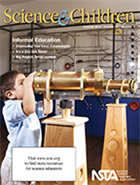 Science and Children
Science and Children
There are many valuable science education resources outside of the classroom. When these are supported by school and home experiences, the impact can be far-reaching. This issue of Science and Children will help you make the most of informal science experiences with your students.
Featured articles (please note, only those marked “free” are available to nonmembers with out a fee):
- A Healthful Balance
- Assessments in the Arguments
- Free – Editor’s Note: Building Language for Science Literacy
- Friction in Different Languages
- Free – Guest Editorial: The BSCS 5E Instructional Model: Personal Reflections and Contemporary Implications
- Free – Observe, Explain, Connect
- Putting the “Her” in Science Hero
- Full Table of Contents
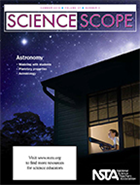 Science Scope
Science Scope
Humans have always been fascinated by the ever-changing night sky and have spent many hours pondering its mysteries. Are we alone in the universe? What would it be like to live on another planet? Why does the night sky change? Explore these and other big questions with the help of this issue of Science Scope, which features lessons about planetary properties, developing student-centric astronomical models, and extreme environments on our planet and beyond.
Featured articles (please note, only those marked “free” are available to nonmembers without a fee):
- Free – Astrobiology: Explorations in Earth and Life Science
- Born to Run: Experimental Evolution of High Voluntary Exercise in Mice
- Free – Editor’s Roundtable: Adding some STEAM to Astronomy
- Including Students in a Model of the Earth, Moon, and Sun System
- Letters! We Get Letters
- Think Instruments, Think Apps: Using App-Based Technology in the Science Classroom
- Full Table of Contents
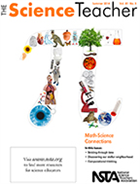 The Science Teacher
The Science Teacher
Reform movements have long championed aligning mathematics and science education. Over more than three decades, various standards documents have extolled the potential synergy that can result when science investigations use mathematics. Now the Next Generation Science Standards (NGSS) extend these important math-science connections by identifying crosscutting concepts, scientific and engineering practices, and disciplinary core ideas important to both science and mathematics. The NGSS also make explicit connections to the Common Core State Standards in mathematics. The articles in this issue of The Science Teacher provide useful ideas about including mathematics in your science teaching.
- Computational Thinking in High School Science Classrooms
- Discovering Our Stellar Neighborhood
- Free – Editor’s Corner: Math-Science Connections
- Graphing the Past
- Striding Through Time
- Free – The Dark Side of the Tube
- Full Table of Contents
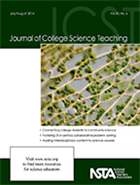 Journal of College Science Teaching
Journal of College Science Teaching
Can social media be successfully integrated into the higher education classroom as an additional information source? Read one study that evaluates the benefits of including Twitter in a semester course to disseminate relevant information and serve as a discussion tool. Also read how two authors used a version of the Jeopardy game in a second-semester general chemistry course to engage students, review the previous semester’s content, and set expectations for the new semester. And in the Two-Year Community column read about the effects of different teaching methods—lecture, blended, and hybrid—on students enrolled in a general biology course with laboratory for majors in a community college.
Featured articles (please note, only those marked “free” are available to nonmembers without a fee):
- A Learner-Centered Molecular Modeling Exercise for Allied Health Majors in a Biochemistry Class
- A Novel Interdisciplinary Science Experience for Undergraduates Across Introductory Biology, Chemistry, and Physics Courses
- Applying the Brakes: How Practical Classroom Decisions Affect the Adoption of Inquiry Instruction
- Beginning a Classroom Inquiry: Using Photovoice to Connect College Students to Community Science
- Collaborative Projects Increase Student Learning Outcome Performance in Nonmajors Environmental Science Course
- Free – Editorial: Bully for You
- General Chemistry II: Setting the Stage on the First Day With Jeopardy
- Research and Teaching: Fostering Collaborative Problem Solving and 21st Century Skills Using the DEEPER Scaffolding Framework
- Research and Teaching: Published Freshman Lab Exercises as Indicators of Awareness and Adoption of Instructional Practices Grounded in Discipline-Based Education Research
- Free – Twitter in the Higher Education Classroom: A Student and Faculty Assessment of Use and Perception
- Full Table of Contents
Science teachers get a break from lesson planning this month, so it’s a nice time to ponder other questions: What informal science experiences are valuable for elementary students? Can middle school students discuss whether or not we are alone in the universe? How do you align mathematics and science at the high school level? Can you integrate social media into the college classroom? Your peers are sharing great ideas in this month’s K–College journals from the National Science Teachers Association.
Laser Blox
By Ken Roberts
Posted on 2014-07-03
The set of Laser Blox classroom lasers that I received for review contained:
- Three wavelengths of Laser Blox—three green (532 nm), one red (635 nm), and one violet (405 nm).
- A durable plastic mount that can hold up to three Laser Blox. The mount is backed with industrial-strength suction cups, which allow it to be mounted to a whiteboard and other smooth surfaces.
- A set of acrylic lenses—six large, magnetic demonstration lenses: a plano-concave lens, a biconvex lens, a biconcave lens, a plano-convex lens, an equilateral prism, and a semicircular lens along with a foam-lined storage case.
My high school students and I found Laser Blox to be a unique and safe way to experiment with light. We began our exploration doing some of the free activities available on the website: gummy bears, microscope demonstration, color and light, and measuring the wavelength of light. Wavelength was a subject that I had previously not used with my general curriculum students because of the time needed to collect the data using a hydrogen gas discharge tube.
However, the Laser Blox made it possible for several groups to collect data at the same time, and we completed the lab within our 40-minute time frame with good results. The groups were able to see the beam/path of the light easily on the wall. This made data collection much simpler than when using the discharge tube.
The magnetic feature of the Laser Blox and the lenses is one of my favorite aspects of the set. Because I can stick them on my whiteboard, I can very easily show how light is able to travel and refract. In addition, the suction mount can hold three lasers, which allows them to be positioned in parallel paths without having to hold them in place. Because the lenses are backed with a magnetic backing, I could then attach different lenses to the whiteboard in the path of the light to show how the different lens shapes bent the light into different patterns.
These lenses are easy to move, allowing students to ask questions, propose changes, and see the effects quickly without a lot of unwieldy manipulation. Having my hands free allowed me to write notes and direct the students’ attention to the phenomenon at hand, without setting pieces down and then trying to realign them afterward.
After using the Laser Blox in my classroom for several months, I moved beyond the free lessons on the website and the typical use of lenses to show diffraction of light. For example, I used the Laser Blox during elementary science night as a safe way to provide demonstrations to students in grades 3 and 4 during a class on colors and chemiluminescence.
During this lesson, the instructor demonstrated how tonic water can be used to create gelatin that glows in the dark. In addition, the students noticed that the lines within the gelatin were not as strong with some of the colors. This was demonstrated with the red Laser Blox and the green one. It led to a discussion about absorption of colors on top of the planned discussion about solutions and luminescence.
In addition, I have shared my set of Laser Blox with the other teachers in my department, with glowing reviews when they were grudgingly returned. Because of this, I recommend Laser Blox as a worthwhile purchase for a science department to support student learning and inquiry in biology, chemistry, and physics classrooms.
An Enchanted Evening With Synchronous Fireflies
By Guest Blogger
Posted on 2014-07-01
The flickering of fireflies has always been one of my favorite things about summer. This regular summer phenomenon always seemed extraordinary to me, so when I started the Next Time You See book series, fireflies were high on the list of topics I wanted to write about. As I researched the book, my fascination with fireflies continued to grow. I had known that fireflies flash in order to mate, but I was amazed to find out that each species has its own flashing pattern, and that the males are the ones we see flying and flashing, while the females stay still and decide whether or not they want to flash back. I was captivated when I came across this photo on nature photographer Judd Patterson’s flickr stream titled “Elkmont Synchronous Firelfies.” I thought, Synchronous fireflies—does that mean what I think it means?
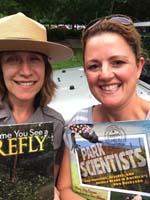 It turns out there are only two places in the world (that we know of) where the fireflies flash in unison. One is in Southeast Asia and the other is a five-hour drive from my home in Cincinnati, in Elkmont, Tennessee. So, I decided right then that I was going to see this for myself.
It turns out there are only two places in the world (that we know of) where the fireflies flash in unison. One is in Southeast Asia and the other is a five-hour drive from my home in Cincinnati, in Elkmont, Tennessee. So, I decided right then that I was going to see this for myself.
It turns out that there is only one week each year that you can see this amazing phenomenon. I missed my chance last summer, but this summer I was ready. I checked the Great Smoky Mountains National Park website regularly to see when scientists predicted the fireflies would be flashing, and in April, as soon as the information was posted, my family made reservations for one of the peak nights, June 9.
June 9 finally came, and that morning, over a Tennessee pancake breakfast, we read about the scientists and park rangers who study the synchronous fireflies in a book by my friend Mary Kay Carson called Park Scientists. While going into the park’s visitor’s center that afternoon, we recognized one of the scientists featured in the book and stopped to take a picture. I took that lucky encounter as a sign that this was going to be a great day.
 When we arrived, we found that hundreds of people were there for the same reason we were. We rode a trolley seven miles into the mountains as the Sun was setting, and we found a nice place in the woods where we sat and waited for the forest to grow dark.
When we arrived, we found that hundreds of people were there for the same reason we were. We rode a trolley seven miles into the mountains as the Sun was setting, and we found a nice place in the woods where we sat and waited for the forest to grow dark.
We found just the right place on the path. We had to bring the book! That’s Judd’s synchronous firefly photo on the cover. I waited for the fireflies with my son, Jack
The forest rangers handed out pieces of red cellophane to cover our flashlights so the fireflies would not be distracted by our lights. First came the blue ghost fireflies, which don’t really flash—they glow a blue light for a few seconds, then the light fades away. Next, we began to see a few random glimmers of yellow light, and before we knew it, the forest was sparkling with thousands of tiny lights. Then it would go completely dark for a few seconds before the light show started again. We counted the flashes of the synchronous fireflies, 1-2-3-4-5-6, and then darkness. Over and over for hours, the forest would be ablaze with flickering lights and then go completely dark. We couldn’t believe our eyes. It was like we were in some kind of magical place—an enchanted forest. My husband likened it to the flash bulbs that go off at the Super Bowl halftime show. It was impossible to capture the full effect of this phenomenon on camera or video. My husband made some long-exposure attempts. His photos were beautiful, but no photo could compare to what we saw as we stood in that enchanted forest.
John Muir said, “In every walk with Nature, one receives far more than he seeks.” This sentiment rang true with us that night. What we experienced was far more amazing than we had ever expected, and the memories we made will last forever.
How Can I Create a Safe Science Classroom?
By Carole Hayward
Posted on 2014-07-01

As a physics and chemistry teacher for over 30 years, Adah Stock learned firsthand the importance of proper safety precautions in the science lab. Stock’s emphasis on safe practices paid off; she only had one small accident in the lab in over 30 years of teaching. Stock, an NSTA member since 1986, is now retired from classroom teaching, but still works in science education as a consultant. She credits NSTA’s journals, conferences, and other services for helping her keep on top of safety practices.
Stock: NSTA absolutely helped me learn about safety precautions for the classroom. The NSTA journals were especially helpful. I particularly enjoy Science Scope’s “Scope on Safety” column and The Science Teacher’s “Safer Science” column. (Note from NSTA: For more information on these columns, see the “Safe Science” blog post from May 2014.)
One journal article I read a while ago talked about how important it is to install ground fault circuit interrupter (GFCI) safety outlets in schools. Students sometimes can be mischievous and put objects into electrical outlets. I learned that the middle school I was teaching in did not have GFCI outlets. So, I presented the NSTA article to my principal, who subsequently installed the safety outlets. Adding the GFCI outlets wasn’t expensive, but was necessary. By reading the articles and learning about what can possibly go wrong, you say to yourself, “I need to watch out for this.”
When I was a chemistry teacher in Texas, my district was building a new high school. The superintendent invited me to look at the specs for the building. When I looked at the specs, I noticed that the chemistry room had only one door. I knew that from reading NSTA articles that you need two doors in a chemistry lab. So, I told the architect, “Where is the other door?” And, he said, “What for? It would ruin the aesthetics of the room.” I told my superintendent that having only one door was a bad safety hazard. What if there is a fire in the lab? Students need another door to get out. My superintendent looked at the architect and said, “Put another door in.” I never got to see that building because I moved away before it was built, but knowing about proper safety precautions helped me prepare the school for the future.
I showed many journal articles to administrators over the years and showed them what the Occupational Safety and Health Administration (OSHA) requires. Sometimes, administrators weren’t aware of what precautions to take and thought that OSHA only pertained to companies, which it doesn’t. I became knowledgeable about safety in the science classroom thanks to NSTA. I would write down when I spoke to the administrators about my safety recommendations, what I suggested, and what NSTA articles I showed them. You have to educate administrators about safety and you have to cover yourself, honestly, in case there is an accident. You need to show that you took the proper steps to prevent the accident.
(Note from NSTA: For additional information, NSTA’s Safety Advisory Board has written a number of safety issue papers that address current safety issues in school science laboratories and classrooms. In addition, NSTA has compiled a list of safety resources that include state agencies, nonprofit and for-profit companies, and science supply houses that provide safety services and products for K–12 teachers and administrators. For a safety handout to give students, see “Safety in the Science Classroom.”)
What other features of your membership have you found helpful?
Stock: I love NSTA Reports because it keeps me up-to-date on current science education news and has provided me with summer opportunities throughout my career. I found out about AAPT’s Physics Teacher Resource Agent program (PTRA) through NSTA Reports and ended up being one of the first teachers to participate in that program in 1986. The program led to amazing opportunities for me and gave me a lifetime friend.
I also love the conferences. The first one I attended was in Dallas. The workshops gave me unbelievable ideas about what I could do in the classroom. And, overall, the conferences gave me energy. I always felt that attending a conference was like taking 12,000 mg of Vitamin C! I became so energized.
And, even though I no longer teach, I still work with teachers through my consulting business. When I want to look for information on a specific topic or grade level, I use the NSTA Learning Center. Coming from my perspective, you don’t have to go the library anymore. Being an NSTA member gives you access to all those articles in the Learning Center; what a terrific resource!
Not a member of NSTA? Learn more about how to join.
Jennifer Henderson is our guest blogger for this series. Before launching her freelance career as a writer/editor, Jennifer was Managing Editor of The Science Teacher, NSTA’s peer-reviewed journal for high school science teachers.
Science of Golf: dimples
By Judy Elgin Jensen
Posted on 2014-07-01
 Think of it as a linear particle accelerator, but instead of atoms, golf balls are propelled at speeds up to 200 miles per hour through a corridor that is 70 feet long and banked with infrared sensors. That’s the tool the United States Golf Association (USGA) Research and Test Center uses to test golf balls. The USGA regulates the diameter and weight of a golf ball, and places standards on speed, distance, and aerodynamics.
Think of it as a linear particle accelerator, but instead of atoms, golf balls are propelled at speeds up to 200 miles per hour through a corridor that is 70 feet long and banked with infrared sensors. That’s the tool the United States Golf Association (USGA) Research and Test Center uses to test golf balls. The USGA regulates the diameter and weight of a golf ball, and places standards on speed, distance, and aerodynamics.
Find out more about the sport of golf and those uniquely dimpled balls with the video springboard Science of Golf: Why Golf Balls Have Dimples, produced by NBC Learn and the USGA. Lesson plans focused on engineering processes developed by NSTA help you take the videos into your classroom, exposing your students to not only another sport, but to the science and engineering behind it.
To find out more about what engineers and others do in “real life,” visit the USGA Research and Test Center. It might be a career path for some of your students.
In the meantime, grab your favorite beverage and give the videos, available cost-free on www.NBCLearn.com, a quick overview. While Martin Kaymer dominated the U.S. Open and Michelle Wie made a clutch birdie to secure a win in the Women’s, there’s more excitement still to come this summer at the U.S. Senior Open, played July 10-13, played in Edmond, Oklahoma.
Find out for yourself what the game—and the science—is all about.
Exotic image of a pink golf ball courtesy of Aftab Uzzaman.
P.S. And although color is not addressed in the video, know that pink balls undergo the same rigorous testing, as do the yellow, blue, green, and fluorescents. As long as it has dimples—it’s fair game!
Video
SOG: Why Golf Balls Have Dimples is about how small depressions on the surface of a golf ball make it unique and especially suited for the game.
STEM Lesson Plan—Adaptable for Grades 7–12
SOG: Why Golf Balls Have Dimples guides students in designing and testing a dimpled golf ball according to criteria and constraints established by the class. It also provides ideas for STEM exploration plus strategies to support students in their own quest for answers.
You can use the following form to e-mail us edited versions of the lesson plans: [contact-form 2 “ChemNow]
 Think of it as a linear particle accelerator, but instead of atoms, golf balls are propelled at speeds up to 200 miles per hour through a corridor that is 70 feet long and banked with infrared sensors. That’s the tool the United States Golf Association (USGA) Research and Test Center uses to test golf balls. The USGA regulates the diameter and weight of a golf ball, and places standards on speed, distance, and aerodynamics.
Think of it as a linear particle accelerator, but instead of atoms, golf balls are propelled at speeds up to 200 miles per hour through a corridor that is 70 feet long and banked with infrared sensors. That’s the tool the United States Golf Association (USGA) Research and Test Center uses to test golf balls. The USGA regulates the diameter and weight of a golf ball, and places standards on speed, distance, and aerodynamics.




